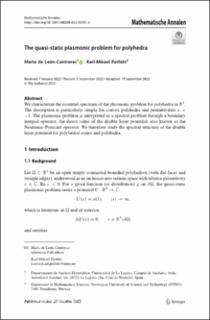| dc.contributor.author | de León-Contreras, Marta | |
| dc.contributor.author | Perfekt, Karl-Mikael | |
| dc.date.accessioned | 2022-11-21T08:43:41Z | |
| dc.date.available | 2022-11-21T08:43:41Z | |
| dc.date.created | 2022-10-26T15:54:57Z | |
| dc.date.issued | 2022 | |
| dc.identifier.citation | Mathematische Annalen. 2022, . | en_US |
| dc.identifier.issn | 0025-5831 | |
| dc.identifier.uri | https://hdl.handle.net/11250/3033044 | |
| dc.description.abstract | We characterize the essential spectrum of the plasmonic problem for polyhedra in R3. The description is particularly simple for convex polyhedra and permittivities ϵ<−1. The plasmonic problem is interpreted as a spectral problem through a boundary integral operator, the direct value of the double layer potential, also known as the Neumann–Poincaré operator. We therefore study the spectral structure of the double layer potential for polyhedral cones and polyhedra. | en_US |
| dc.language.iso | eng | en_US |
| dc.publisher | Springer Nature | en_US |
| dc.rights | Navngivelse 4.0 Internasjonal | * |
| dc.rights.uri | http://creativecommons.org/licenses/by/4.0/deed.no | * |
| dc.title | The quasi-static plasmonic problem for polyhedra | en_US |
| dc.title.alternative | The quasi-static plasmonic problem for polyhedra | en_US |
| dc.type | Peer reviewed | en_US |
| dc.type | Journal article | en_US |
| dc.description.version | publishedVersion | en_US |
| dc.source.journal | Mathematische Annalen | en_US |
| dc.identifier.doi | 10.1007/s00208-022-02481-x | |
| dc.identifier.cristin | 2065346 | |
| cristin.ispublished | true | |
| cristin.fulltext | original | |
| cristin.qualitycode | 2 | |

